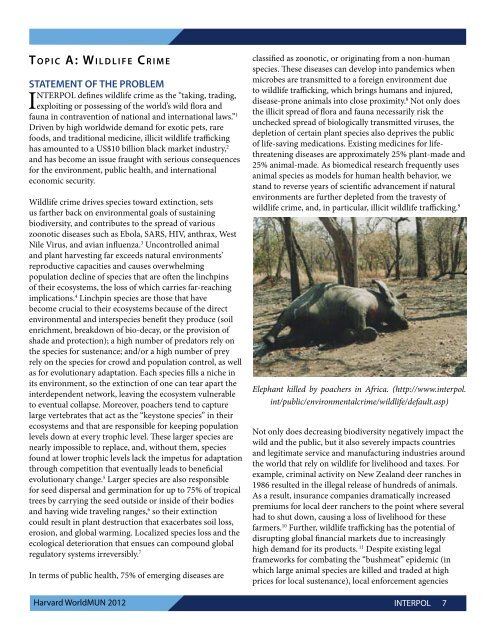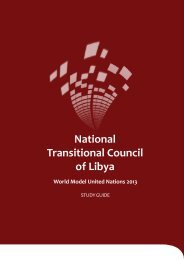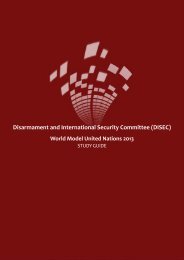INTERPOL - World Model United Nations
INTERPOL - World Model United Nations
INTERPOL - World Model United Nations
You also want an ePaper? Increase the reach of your titles
YUMPU automatically turns print PDFs into web optimized ePapers that Google loves.
T OPI C A: W I LDLI FE CRIME<br />
STATEMENT OF THE PROBLEM<br />
<strong>INTERPOL</strong> denes wildlife crime as the “taking, trading,<br />
exploiting or possessing of the world’s wild ora and<br />
fauna in contravention of national and international laws.” 1<br />
Driven by high worldwide demand for exotic pets, rare<br />
foods, and traditional medicine, illicit wildlife tracking<br />
has amounted to a US$10 billion black market industry, 2<br />
and has become an issue fraught with serious consequences<br />
for the environment, public health, and international<br />
economic security.<br />
Wildlife crime drives species toward extinction, sets<br />
us farther back on environmental goals of sustaining<br />
biodiversity, and contributes to the spread of various<br />
zoonotic diseases such as Ebola, SARS, HIV, anthrax, West<br />
Nile Virus, and avian inuenza. 3 Uncontrolled animal<br />
and plant harvesting far exceeds natural environments’<br />
reproductive capacities and causes overwhelming<br />
population decline of species that are oen the linchpins<br />
of their ecosystems, the loss of which carries far-reaching<br />
implications. 4 Linchpin species are those that have<br />
become crucial to their ecosystems because of the direct<br />
environmental and interspecies benet they produce (soil<br />
enrichment, breakdown of bio-decay, or the provision of<br />
shade and protection); a high number of predators rely on<br />
the species for sustenance; and/or a high number of prey<br />
rely on the species for crowd and population control, as well<br />
as for evolutionary adaptation. Each species lls a niche in<br />
its environment, so the extinction of one can tear apart the<br />
interdependent network, leaving the ecosystem vulnerable<br />
to eventual collapse. Moreover, poachers tend to capture<br />
large vertebrates that act as the “keystone species” in their<br />
ecosystems and that are responsible for keeping population<br />
levels down at every trophic level. ese larger species are<br />
nearly impossible to replace, and, without them, species<br />
found at lower trophic levels lack the impetus for adaptation<br />
through competition that eventually leads to benecial<br />
evolutionary change. 5 Larger species are also responsible<br />
for seed dispersal and germination for up to 75% of tropical<br />
trees by carrying the seed outside or inside of their bodies<br />
and having wide traveling ranges, 6 so their extinction<br />
could result in plant destruction that exacerbates soil loss,<br />
erosion, and global warming. Localized species loss and the<br />
ecological deterioration that ensues can compound global<br />
regulatory systems irreversibly. 7<br />
In terms of public health, 75% of emerging diseases are<br />
classied as zoonotic, or originating from a non-human<br />
species. ese diseases can develop into pandemics when<br />
microbes are transmitted to a foreign environment due<br />
to wildlife tracking, which brings humans and injured,<br />
disease-prone animals into close proximity. 8 Not only does<br />
the illicit spread of ora and fauna necessarily risk the<br />
unchecked spread of biologically transmitted viruses, the<br />
depletion of certain plant species also deprives the public<br />
of life-saving medications. Existing medicines for lifethreatening<br />
diseases are approximately 25% plant-made and<br />
25% animal-made. As biomedical research frequently uses<br />
animal species as models for human health behavior, we<br />
stand to reverse years of scientic advancement if natural<br />
environments are further depleted from the travesty of<br />
wildlife crime, and, in particular, illicit wildlife tracking. 9<br />
Elephant killed by poachers in Africa. (http://www.interpol.<br />
int/public/environmentalcrime/wildlife/default.asp)<br />
Not only does decreasing biodiversity negatively impact the<br />
wild and the public, but it also severely impacts countries<br />
and legitimate service and manufacturing industries around<br />
the world that rely on wildlife for livelihood and taxes. For<br />
example, criminal activity on New Zealand deer ranches in<br />
1986 resulted in the illegal release of hundreds of animals.<br />
As a result, insurance companies dramatically increased<br />
premiums for local deer ranchers to the point where several<br />
had to shut down, causing a loss of livelihood for these<br />
farmers. 10 Further, wildlife tracking has the potential of<br />
disrupting global nancial markets due to increasingly<br />
high demand for its products. 11 Despite existing legal<br />
frameworks for combating the “bushmeat” epidemic (in<br />
which large animal species are killed and traded at high<br />
prices for local sustenance), local enforcement agencies<br />
Harvard <strong>World</strong>MUN 2012 <strong>INTERPOL</strong> 7

















